One day in early May, I was driving past the hardware store. I glanced over in the direction of the gardening center and what I saw made me slam on the brakes.
Finally, after months and months of dreary winter and mushy spring, the flowers had arrived. I turned into the parking lot and practically sprinted to the colorful array of blooms.
I often choose flowers by color and hardiness. Yellows, purples, pinks, and blues are my favorites, even better if they’re perennial and hardy to winter temperatures that reach -20°F and below.
That day, I stumbled upon a row of flowers that made my breath catch in my throat. Tall, stately columns bursting with blooms of blue and purple.
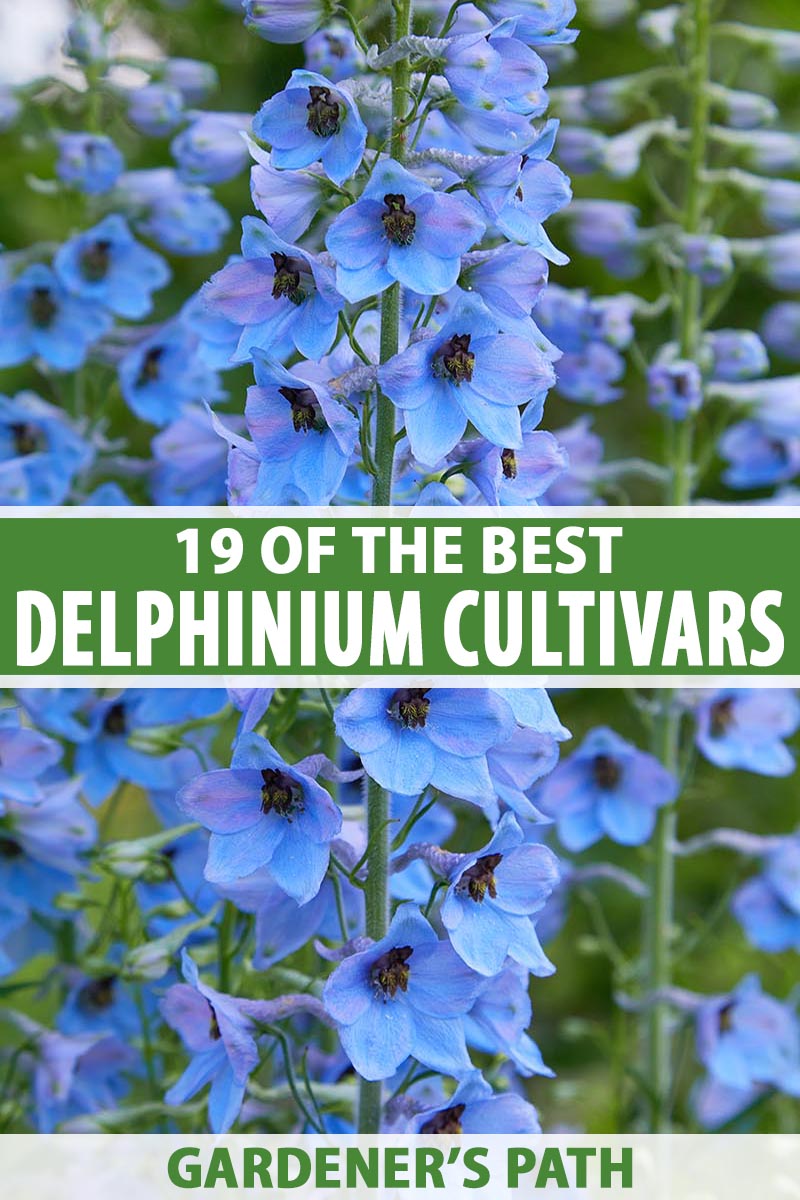
We link to vendors to help you find relevant products. If you buy from one of our links, we may earn a commission.
These were delphiniums. At first I thought they were annual larkspur, and indeed the two are closely related and often. go by the same common name. For more on that relationship, check out our guide to growing delphiniums.
Holding my breath, I checked the tag. I had to have these flowers in my flower bed. I only hoped they’d be hardy enough to survive the winter and return year after year.
Hardy to Zone 3, read the tag. -30 to -40°F.
I suppressed a delighted screech and scooped three plants into my shopping cart.
The beautiful plants (Delphinium spp.) found a home in my front flower bed and have (mostly) thrived there for three summers now.
Have I had enough of these regal members of the Ranunculaceae family yet?
No. No, I have not. Not even close.
I’m planning to clear out the flower bed on the other side of my front stoop and make it into a delphinium bed as well.

I cannot wait for the opportunity to glance at my red house from the front and see scores of purply-blue spires reaching for the white-bordered windowsills.
In preparation for my new additions to this delightful garden, I’ve discovered 19 of the best cultivars to grow at home.
And I’d like to share them with you so that you, too, can sow these dazzling beauties all over your garden and yard.
19 of the Best Delphinium Cultivars
While these plants do well in super-cold climates, like that of Zone 3, you can also grow them in climates all the way up to Zone 7, and sometimes even 8 with the right protection against the heat.
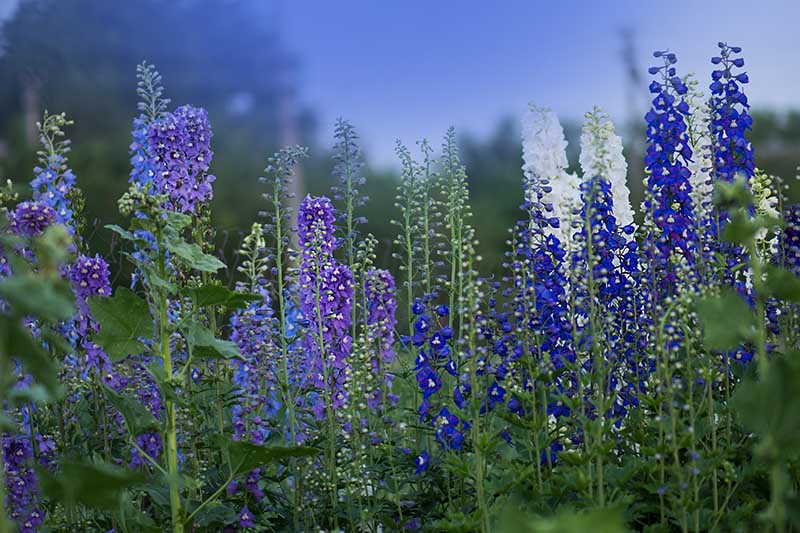
To help these hardy perennials live for many years, they should be allowed to grow just one spike in the first year. Prune any others away before they bloom.
In the second year, you can allow up to three spikes to grow, pruning away any additional growth.
By the third year, plants can support five spikes each.
After this, your delphinium will be well established and prepared to support all the spikes it wishes.
By being vigilant with your pruning, you give the plant a chance to develop a strong, healthy root system. This will help ensure that its life extends beyond just three or four years.
Now, a note on the available species and series.
The three most common species are D. elatum, D. grandiflorum, and D. chelianthum. From these species, various series of cultivars have been developed. The most notable of these are:
- Aurora Hybrids, bred by Japanese company Takii Seed
- Delphina Hybrids, a compact cultivar derived from D. elatum
- Guardian Series, bred for mid-spring blooming and late summer reblooming
- Highlander Series, an enormous, Scotland-born D. elatum cultivar
- Magic Fountains, cultivated from D. elatum and sometimes called Candle Larkspur or Alpine Delphinium
- New Zealand Hybrids, mostly derived from D. elatum and also called Dowdeswell’s Delphiniums after their primary breeder, based in New Zealand
- Pacific Giant Hybrids, developed from D. elatum and popular on the Pacific side of the United States
In addition to these series, there are three botanical groupings for delphiniums. Some cultivars fall in one of the groups below as well as one of the series described above. Others are part of a group but not a series, and vice versa. These are as follows:
- Belladonna Group (D. x belladonna, a cross of D. elatum and D. chelianthum)
- Elatum Group (D. elatum cultivars)
- Grandiflorum Group (D. grandiflorum cultivars)
One more thing you should know is that the center of each bloom is called the “bee.” Sometimes, it really does look like a bee sucking nectar from the middle of the flower.
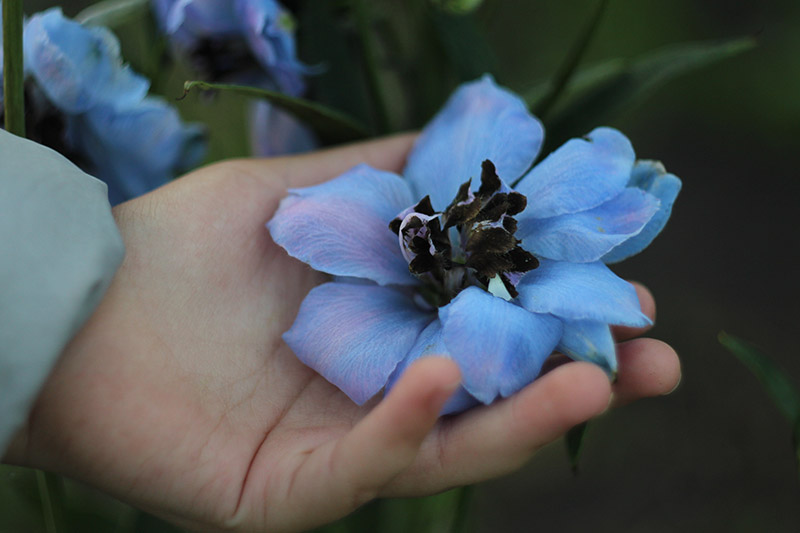
Are you thoroughly confused? I hope not, but sometimes the details of these beloved, long-cultivated flowers can give our brains a spin.
Let’s smooth things out with my lovely list of the best delphinium cultivars ever. There’s sure to be a perfect selection (or three) for everyone.
1. Atlantis
The dark violet color of this exquisite Belladonna Group member would make even the hardest heart flutter with amazement.
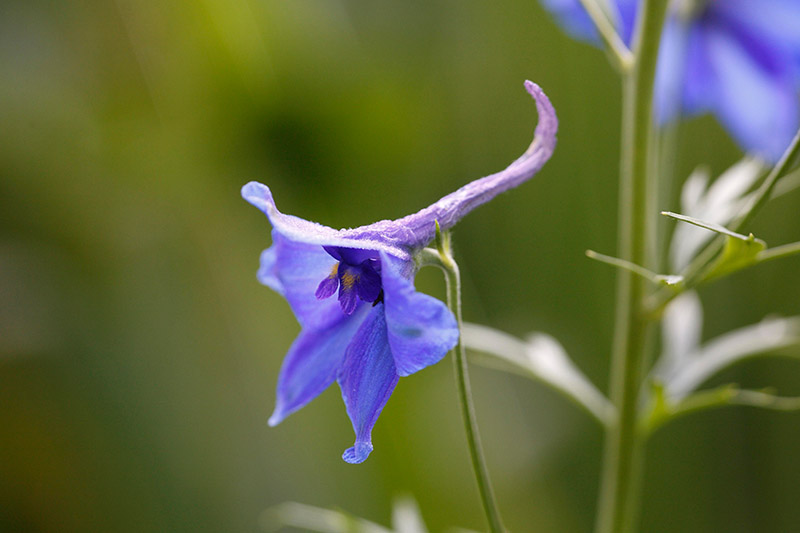
With a mounding habit and a spread of 18-23 inches, this cultivar makes an excellent addition to a perennial bed or container garden.
‘Atlantis’ grows up to 36 inches in height, making it smaller than other cultivars but larger than the smallest Grandiflorums.
2. Aurora Lavender
Like other members of the Aurora series, ‘Aurora Lavender’ boasts smaller leaves than other cultivars, making it ideal for cutting and adding to bouquets.

‘Aurora Lavender’ grows up to 48 inches tall and spreads 20 inches, making it an excellent choice for those of you who want a middle-of-the-road delphinium… as far as height goes.
Otherwise, there’s nothing middle-of-the-road about the color or splendor of ‘Aurora Lavender.’ With lilac-colored petals set off by a white bee, these would look stunning against the walls of my house. Or yours. Or anyone’s, really.
I dream of seeing ‘Aurora Lavender’ cut and placed in a vase, displayed on my old round table by a window. Maybe it’s time to make this dream a reality and get my hands on some seeds.
3. Black-Eyed Angels
Are you looking for a striking cultivar that would make an excellent cut flower?

With fine stems, extra spikes at maturity, and black bees against white petals, ‘Black-Eyed Angels’ is a New Zealand hybrid fit for the finest bouquets.
With its height of three to five feet, it’ll also look dazzling in your yard or garden. Some bees are striped black while others are pure black, giving each spike a delicious texture.
4. Black Knight
With its inky, purple-blue blossoms, ‘Black Knight’ is a showstopper among lighter-hued perennials in the flower bed. It also acts as the dark, contrasting anchor for any purple-themed bouquet.
Growing up to six feet tall, this Pacific Giant hybrid makes a thrilling border when combined with ‘Blue Lace,’ ‘Guinevere,’ and ‘Galahad.’
Find seeds online at True Leaf Market.
5. Blue Elf
If you need a magical pick-me-up, try planting ‘Blue Elf,’ a delicate, vibrant dwarf member of the Grandiflorum Group. Every part of this cultivar is more dainty than other cultivars, from its wispy stems to its lacy leaves.
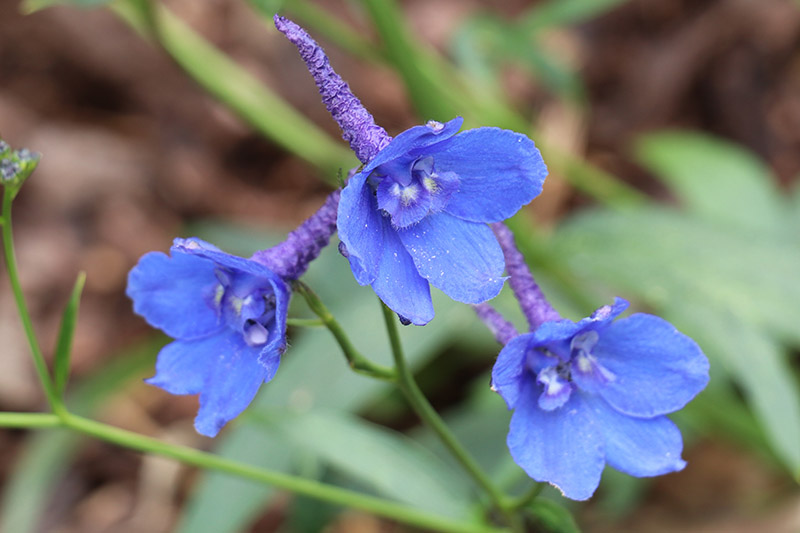
Each tiny blue blossom is shaped like a trumpet and flanked with a spur.
And don’t think ‘Blue Elf’ is delicate in constitution because of its small stature – it’s just as hardy as any other delphinium.
This plant grows just 12 inches tall, making it perfect for decorative front-stoop containers.
I plan to plant ‘Blue Elf’ alongside another round of lilac-colored violas in my spring containers next year.
6. Blue Lace
When I saw this New Zealand hybrid cultivar in a photo, I knew I had to have it in my own flower bed.
The blue of these blooms hints at violet but never fully crosses the line. The bee is sometimes black and sometimes white.
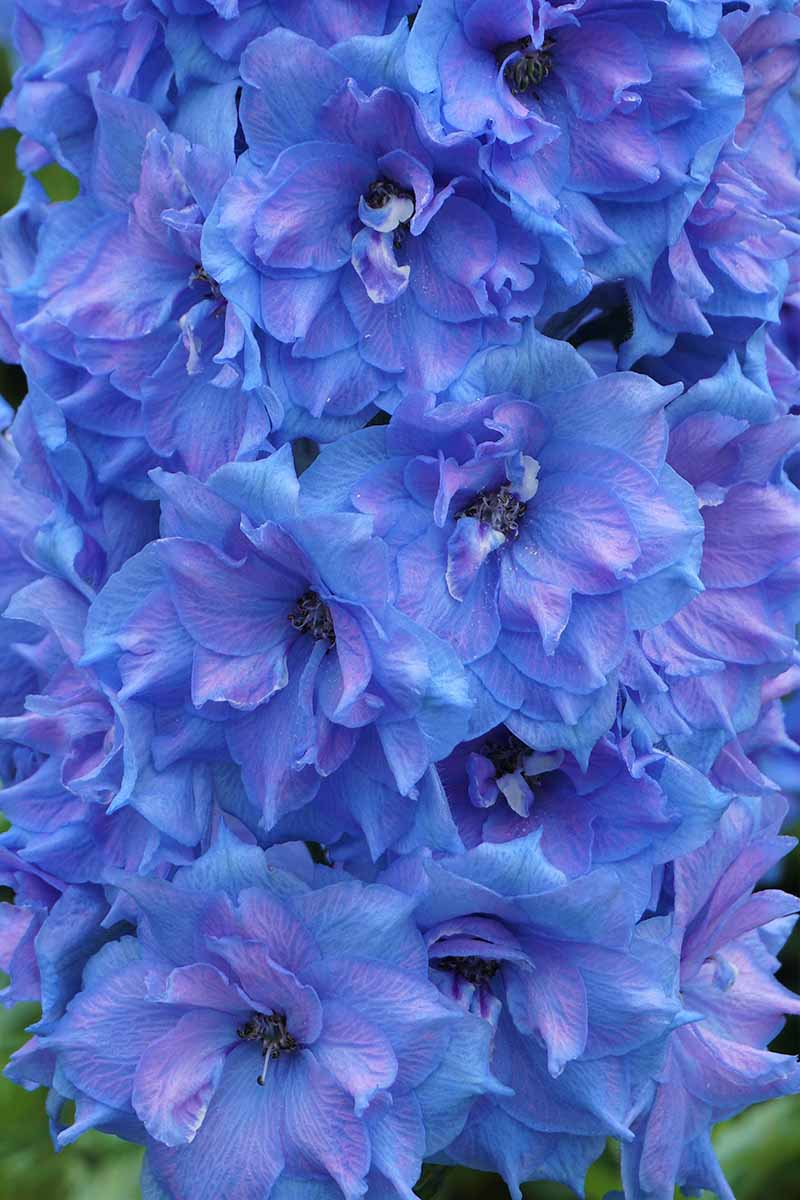
If you love a tall flower, then you’ll really adore ‘Blue Lace’ because it can reach heights of nearly six feet.
Imagine a border of these blue-faced beauties along a fence or garden. Wouldn’t it be sublime?
I’ll be planting these in midwinter for a bounty of shoots in the spring. And then I will patiently wait for another year until they bloom in that brilliant azure hue, setting off the red exterior walls of my home.
7. Cherry Blossom
Do you love a blush of pink blossoms more than anything else in the world?
Then ‘Cherry Blossom’ is the cultivar for you. Part of the Magic Fountains series, ‘Cherry Blossom’ blooms a delicate pink color with a white or pink bee.
With flower-packed spikes, this cultivar is indeed a fountain of color. Imagine how gorgeous it would look against a yellow, blue, or gray house!
You’ll have to exercise patience, as the flowers won’t usually bloom in their first year.
But when that second year of maturity comes? Those 24 to 36-inch columns will be celestial.
8. Cobalt Dreams
Do you dream in shades of indigo? Then you’ll love ‘Cobalt Dreams,’ a New Zealand New Millennium hybrid that embodies everything bright and beautiful about the color blue.
The white bees really do some stunning work, providing a sharp contrast for the electric-bright petals.
And with a spread of one to two feet and a height of four to six feet, ‘Cobalt Dreams’ is anything but shy.
It’s a cultivar for the bold, and I’d wager it’ll have people slowing down their cars as they drive by your home to gape in awe at the sapphire spires.
9. Flamenco
This frilly Highlander Series bloom takes me right back to a summer spent in Spain, when I tried to learn flamenco dance.
It’s a lot harder than it looks.
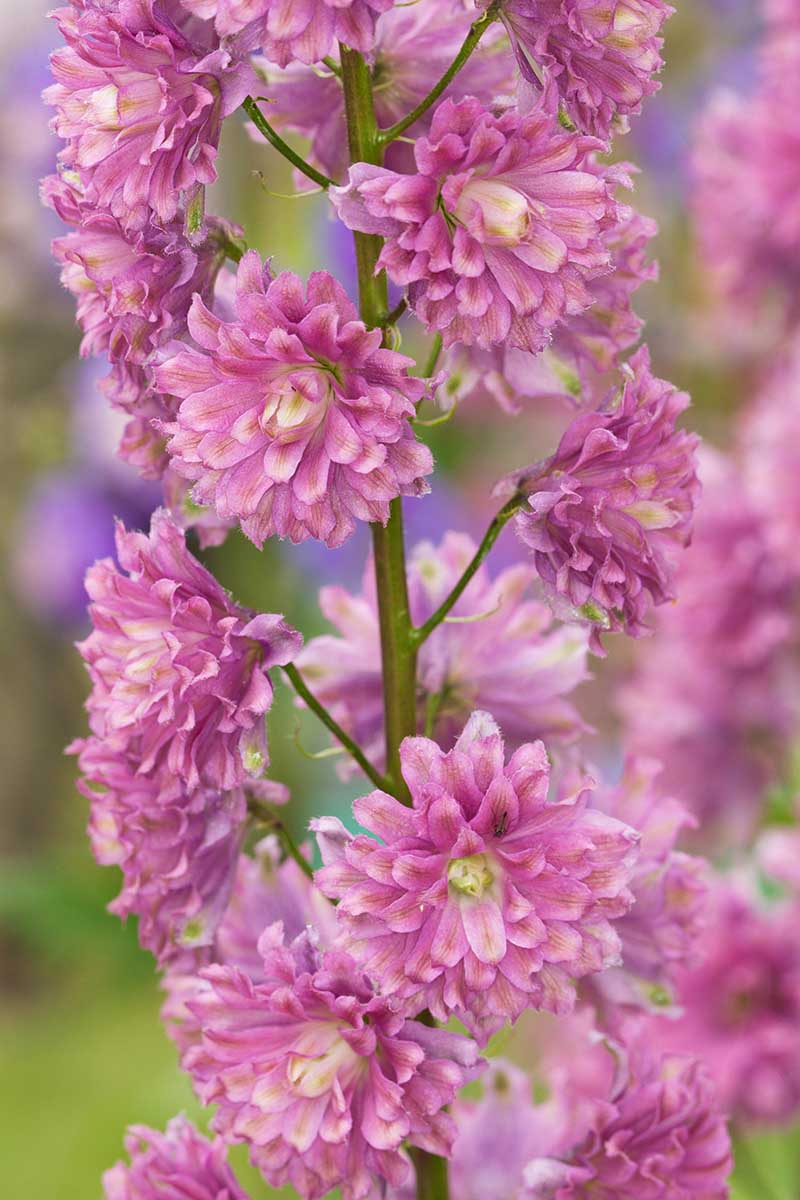
But there’s nothing difficult about gazing at the glory that is ‘Flamenco,’ with its full, ruffled pinkish-white and raspberry-colored blooms that defy the bounds of what a delphinium should look like.
These flowers grow up to 48 inches tall and add some Spanish-inspired zest and vigor to any garden.
10. Galahad
For a bridal-white show of splendor, try planting ‘Galahad,’ a Pacific Giant hybrid cultivar that’s as white and frothy as the wedding gown I wore seven years ago.
‘Galahad’ would look amazing planted next to darker purple delphiniums, or grown all on its own for a striking display of snowy petals.
With a white bee at the center of each blossom, the uniformity of color is awe-inspiring.
Like other Pacific Giant hybrids, ‘Galahad’ grows to anywhere from 48 to 60 inches tall.
11. Guardian Early Blue
With blossoms that bloom even earlier than other Guardian Series cultivars, ‘Guardian Early Blue’ is the perfect satiny-blue delphinium for those of us who want to sow cultivars that cover as much of the season as possible.
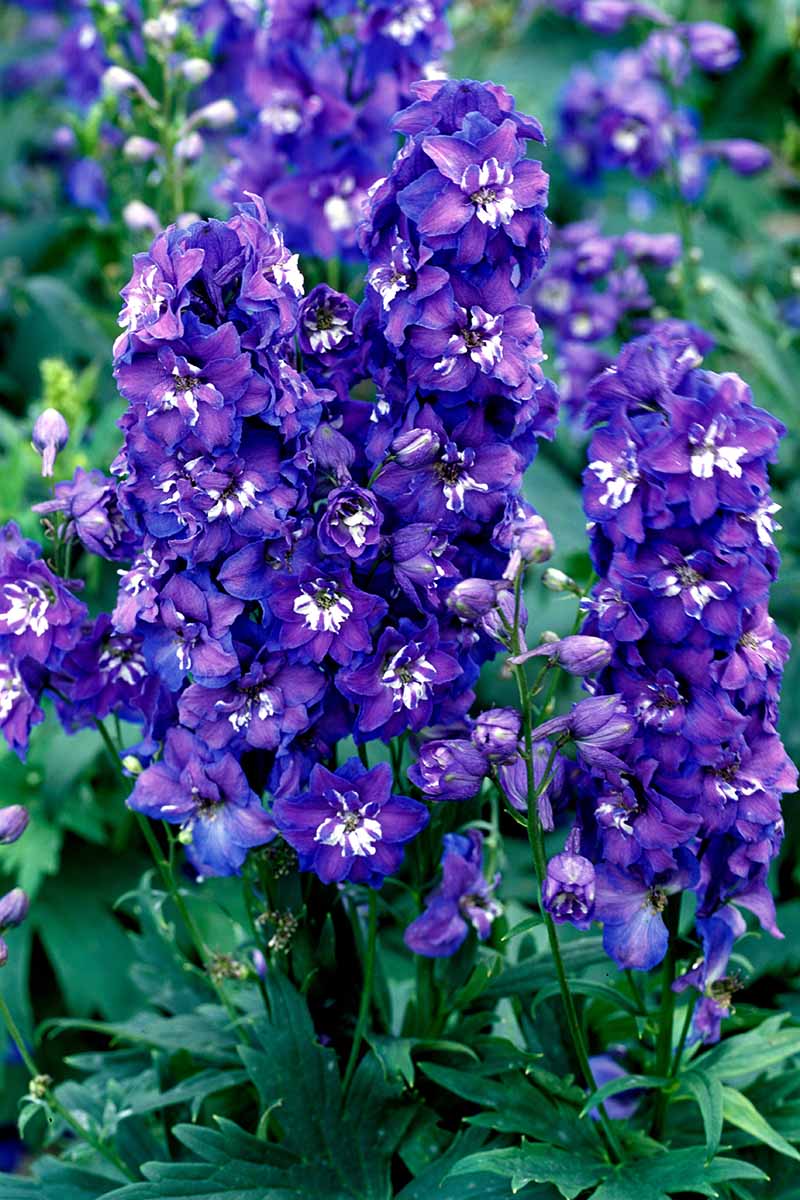
While the first spikes of ‘Guardian Early Blue’ are spent by early summer, it reblooms in late summer, a thrilling bookend to all the delphs that bloom in between.
A midsized plant, ‘Guardian Early Blue’ grows to about 33 inches in height and spreads 18 to 23 inches.
12. Guinevere
With delicate petals that end in elfin points, ‘Guinevere’ is a perennial that closely resembles its annual cousin, larkspur.
Decorated in lavender-pink blooms with a white bee, these delightful Pacific Giant hybrids grow up to 60 inches tall.
‘Guinevere’ would look lovely next to ‘Morning Lights’ or ‘Blue Lace.’
Find your seeds at True Leaf Market.
13. Improved Sky Blue
This Magic Fountains cultivar is definitely the color of the sky, but not the bright afternoon blue that might first come to mind.
Instead, ‘Improved Sky Blue’ is the color of twilight, or dawn – that magical, dark purple-blue blend of color that makes me feel like I can do anything, if only I were able to drink in enough of its beauty.
Plants grow up to 36 inches tall and spread 36 inches wide.
Find your seeds today at True Leaf Market.
14. Morning Lights
Are you seeking a slice of that morning shimmer of bluish-mauve that we call dawn? Then you won’t want to miss planting at least one ‘Morning Lights’ in your garden.
This celestial New Zealand New Millenium Series hybrid features light purple inner petals and blue outer ones, resulting in a gasp-worthy blend of color.

The topmost flowers tend to have more purple petals while blooms down lower on the stalk are more blue, for a deeply pleasing spectrum of shades set off by a white bee.
‘Morning Lights’ grows to 36-60 inches in height at maturity.
15. Princess Caroline
Do you reel at the beauty of a freshly caught Alaska salmon? Then this six-foot delphinium is for you. ‘Princess Caroline’ may have a regal name, but her color is the pink-red of the famed fish.

I think she’d look stunning against a yellow or white-walled home, or planted among yellow coreopsis.
It’d be just like catching a pink salmon on a perfect sunny day.
16. Rose White Bee
If you’re enthralled with roses but want to try growing delphiniums, choose the Delphina Series cultivar, ‘Rose White Bee.’
This compact flower grows to only 18-20 inches with a 16-inch spread, but the blooms are robustly rosy-colored and backed by an extra-strong stem.
The plant looks just like the larger delphinium cultivars, only it’s not nearly as enormous.
Each petal blushes in shades of dark and light pink with a white bee in the center.
17. Summer Skies
For a breath of fresh, delicate blue color, try planting the Pacific Giants hybrid, ‘Summer Skies.’ True to its name, this bloom holds the promise of a sunny blue morning in its petals.
With its daintily pointed petals and pretty white bee, ‘Summer Skies’ is sure to make you smile upon its first flush of blossoms.
And though its flowers may be dainty, its stature is true to its series – this type reaches heights of 48-60 inches with a 24-36-inch spread of floreted spikes.
Try planting this one among lavender, whose deep purple will contrast nicely with the delphinium’s pale blue.
18. Sweethearts
As soft and luminous as the first hints of love, ‘Sweethearts’ is a pale pink New Millennium hybrid with a sweet white bee.
So sweet is this cultivar that in 2009, it won the Garden Merit Award from the Royal Horticultural Society in Wisley, England.
If you want this award-winner in your garden, be prepared for towering, three to five-foot spikes of gentle pink color.
19. Sweet Sensation
Have you ever wanted to travel to Scotland? Me, too, but I haven’t made it there yet.
One day, I will. But for now, I’ll stare at these absolutely riveting, three-foot-tall ‘Sweet Sensation’ plants, which belong to the Scotland-bred Highlander series.
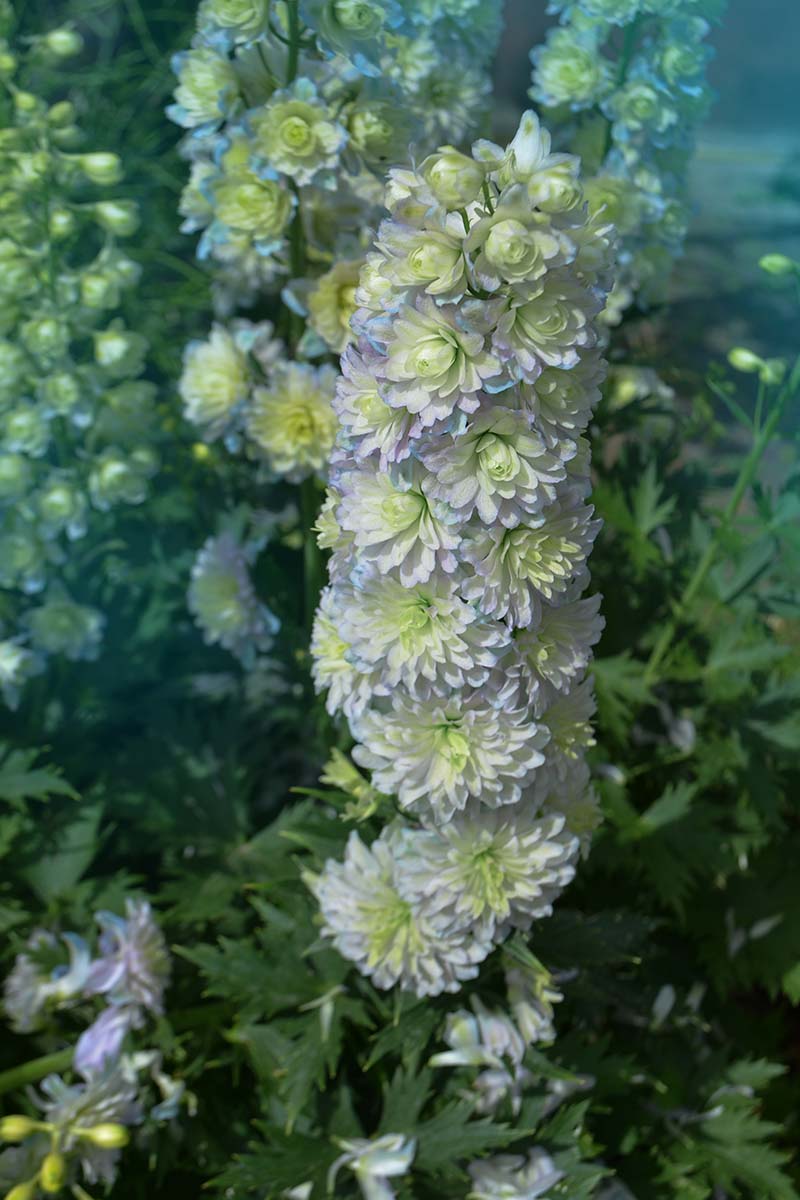
With blue, violet, and white flowers that bloom from the center like roses, ‘Sweet Sensation’ sends a nostalgic yet exciting thrill through one’s bones.
Just imagine them in a vase on your kitchen counter. Wouldn’t they be divine?
Delphiniums for Days
I would love to see someone sow seeds from every single one of these cultivars for the ultimate epic delphinium garden.
Any takers?
Maybe it’ll have to be me.
Tell me, which cultivar is your favorite? Are you more a fan of pinks and purples, or blues and whites? Do you love them all, like I do?
Drop me a line in the comments! I love hearing from you.
And don’t forget to browse these delightful selections of flowers for your garden next:
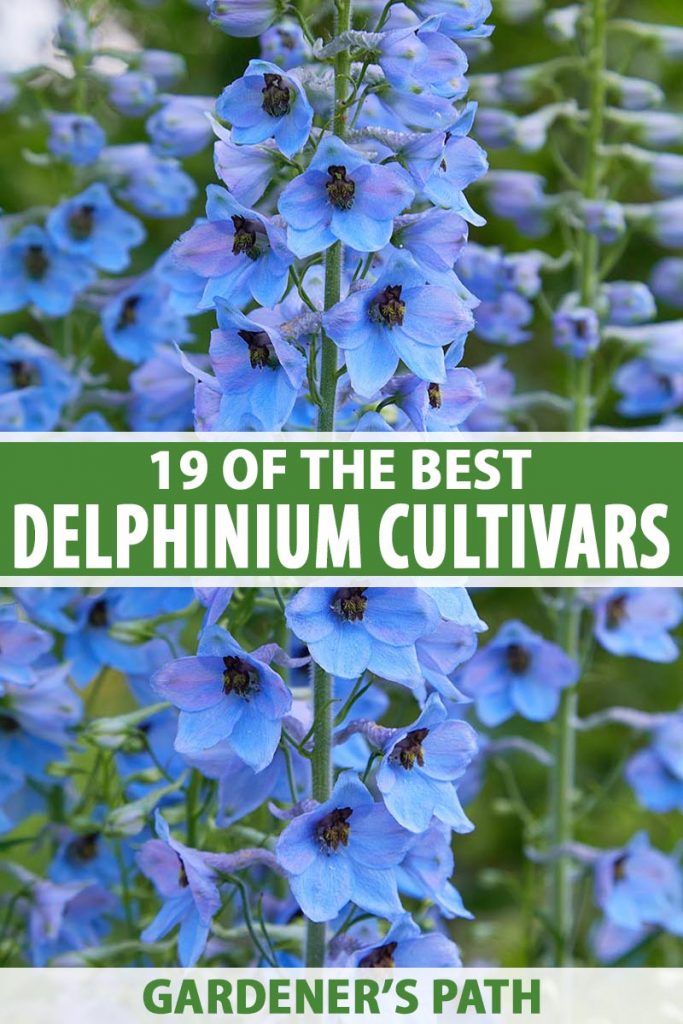
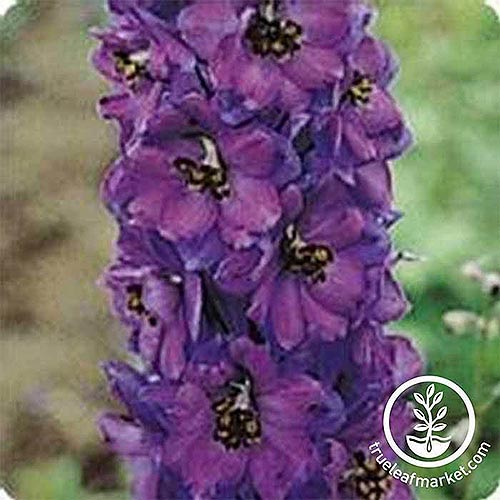
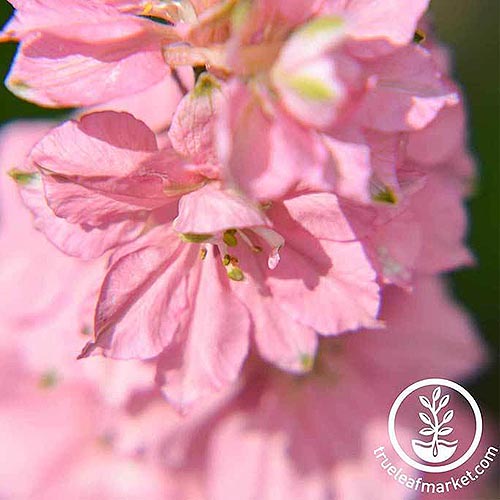

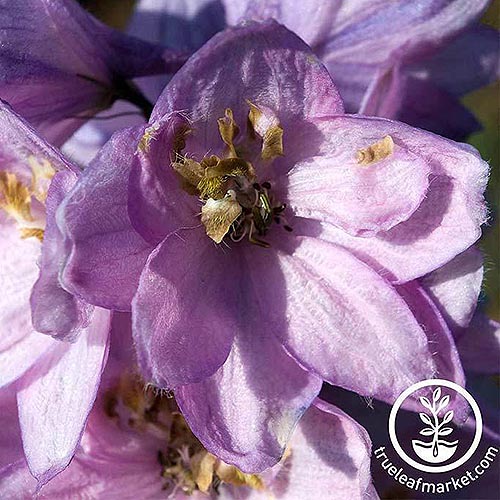
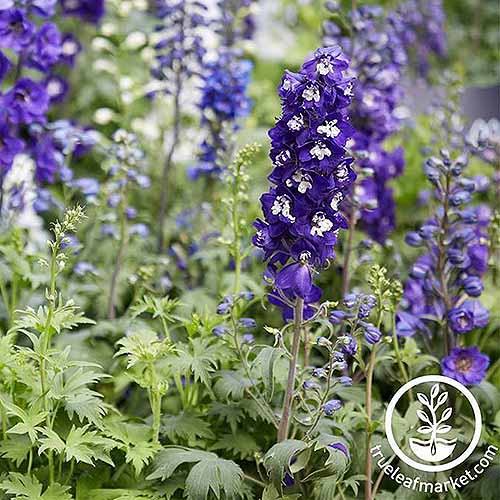
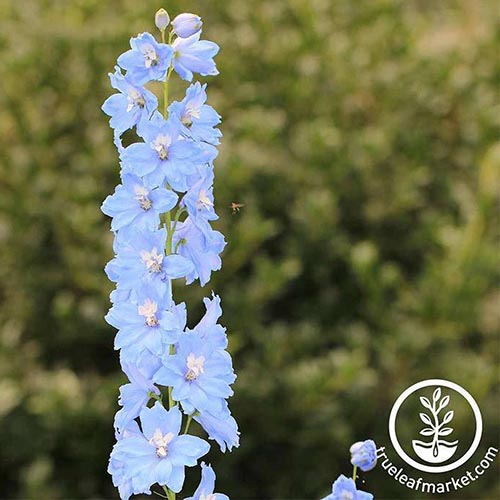

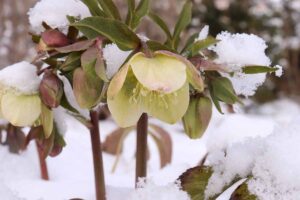
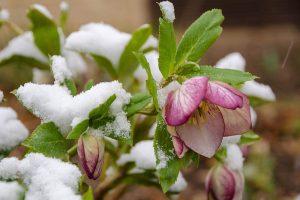
I just caught the Delphinium bug and I was looking for a local source when I found your blog. Thank you for the overview of Delphinium hybrids it will focus my search.
Which variety is in the photo that starts this article? Pink and blue with dark bee. It is not identified.
Although it appears much paler here than what is typical, according to the photographer this is D. x elatum ‘Pagan Purples.’
I’m not sure what these flowers are but they said Delphiniums on the pot when I bought them. Could you help me out?
Hello Shauna. What a beautiful ornamental! Based on the structure of the flower stalks and those wide, lanceolate leaves with their sawtooth margins, I’d imagine this is a Digiplexis, a trademarked ornamental that includes foxglove as a parent plant.
Here’s an example of one of the Digiplexis featured in our roundup of digitalis varieties to grow in the garden, ‘Illumination Flame.’
Be sure to get familiar with the toxic traits of foxglove while you have this plant. Our guide tells more.
Thanks for reading Gardener’s Path.